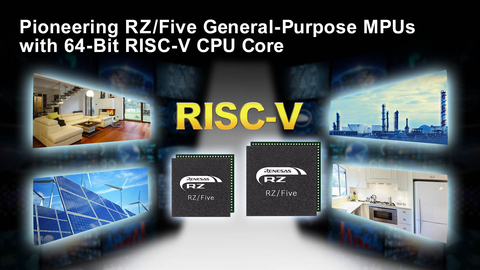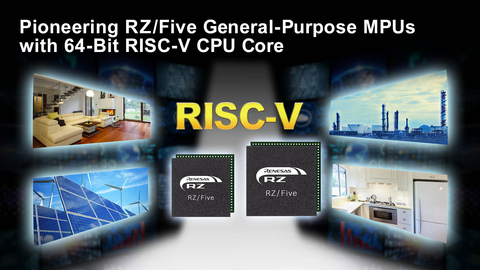I reckon Akida will be in the DRP-AI this year.
Highest power efficiency is realized with the combination of DRP‑AI hardware and the DRP‑AI Translator tool. Our complimentary DRP‑AI Translator software tool supporting ONNX can be used easily to convert AI models to an executable format. Programmable DRP‑AI architecture allows scaling of more advanced Vision AI models with the same RZ/V MPUs resulting in lower development cost and faster time‑to‑market for Vision AI products.
Choose between simple ISP functions, provided by RZ/V2L, for more flexibility in developing Vision AI systems and hardware ISP functions, equipped in RZ/V2M, that are tuned in advance by experts to provide the best image quality.
Let your creativity flow with the winning combination solutions – HMI SoM with AI Accelerator and AI Camera & Voice Recognition Solution – for your next Vision AI design.
You are using an out of date browser. It may not display this or other websites correctly.
You should upgrade or use an alternative browser.
You should upgrade or use an alternative browser.
Renesas
- Thread starter Makeme 2020
- Start date
I am gonna go so far to say that if Akida is not a part of the DRP-AI this year then I’m going to fade away into the Sunset. And if we are I will be doing donuts in my new EQXXX.
Link to the above:
Link to the above:
Fullmoonfever
Top 20
Not yet unfortunately...hopefully getting closer though
Though from BRN site awhile ago they posted from the EETimes...excerpt re Syntiant tech outlining some key differences to Akida first.
In the recent article second below even Syntiant CEO advised previously their tech is primarily audio processing. My red bold.
Another option for keyword spotting is the Syntiant NDP101 chip. While this device also operates at comparable low power (200 microwatts) it is a dedicated audio processor that integrates an audio front end, buffering and feature extraction together with the neural network. Syntiant expects to replace digital MACs with an in-memory analog circuit in the future to further reduce power.
The Akida chip has the added advantages of on-chip learning and versatility. It can also be reconfigured to perform sound or image classification, odor identification or to classify features extracted from data. Another advantage of local processing is that no images or data are exposed on the Internet, significantly reducing privacy risks.
Applications for the technology range from voice-activated appliances to replacing worn-out components in manufacturing equipment. The technology also could be used to determine tire wear based on the sound a tire makes on a road surface. Other automotive applications include monitoring a driver’s alertness, listening to the engine to determine if maintenance is required and scanning for vehicles in the driver’s blind spot.
We expect Akida to evolve, incorporating the structures of the brain, particularly cortical neural networks aimed at artificial general intelligence (AGI). This is a form of machine intelligence that can be trained to perform multiple tasks. AGI technology can be used for controlling autonomous vehicles, with sufficient intelligence to control a vehicle and eventually learn to drive much like humans learn. To be sure, there will be many intermediate steps along the way to that goal
Syntiant Raises $55 Million, Ships 20 Million+ Chips
By Sally Ward-Foxton 03.30.2022 0Share Post
Ultra–low power AI accelerator startup Syntiant has closed a funding round of $55 million, bringing the company’s total raise to around $100 million. The company, which was founded in 2017, was backed by new and existing investors.
Syntiant also announced that it has shipped more than 20 million of its neural decision processor chips to date, making it one of the few edge AI chip startups shipping in substantial volumes today.
Among five new investors this round was Renesas Electronics Corp. Syntiant and Renesas have been collaborating on a “voice–controlled multimodal AI solution” since last summer, which combines Renesas’ RZ/V series microprocessors with Syntiant’s NDP120. This design uses Syntiant’s always–on neural decision processor to enable voice activation for a variety of vision–based AI applications, which are performed on the Renesas chip; all while keeping the standby power very low.
“By leveraging Syntiant’s leadership position in deep learning edge compute, our collaborations are enhancing user experiences through advanced AI–based voice and vision processing solutions across many use cases, such as security systems, personal devices, industrial and manufacturing, transportation, and logistics,” said Sailesh Chittipeddi, executive vice president and general manager of Renesas’ IoT and infrastructure business unit, in a statement.
 Kurt Busch (Source: Syntiant)
Kurt Busch (Source: Syntiant)The NDP120 is an SoC featuring Syntiant’s second generation AI accelerator core alongside a Tensilica HiFi3 DSP for feature extraction and an Arm Cortex–M0 core for system management. The second–generation Syntiant core offers scope for bigger neural networks than its predecessor, including running multiple neural networks simultaneously. This might include keyword/wake word detection, speaker ID and/or command detection.
“The NDP120 can bring the level of performance that you would typically find in a plugged–in smart speaker to a battery powered device, that’s really the goal for this product,” Syntiant CEO Kurt Busch told EE Times in a previous interview. “The NDP120 is primarily for audio [processing] as well as sensor fusion, with one or more of those sensors being a microphone… for far–field and noise clean up. It’s ideal for [AI–powered] noise reduction.”
Syntiant said the recent round of funding will be used to accelerate deployment of its third–generation neural decision processor core, as well as continuing work on software development. The company expects to debut third–gen products next year.
I don’t think Syntiants inclusion excludes ours. I have convinced myself that we will be a part of the Renesas’s DRP-AI this year. No turning back now. LolNot yet unfortunately...hopefully getting closer though
Though from BRN site awhile ago they posted from the EETimes...excerpt re Syntiant tech outlining some key differences to Akida first.
In the recent article second below even Syntiant CEO advised previously their tech is primarily audio processing. My red bold.
Another option for keyword spotting is the Syntiant NDP101 chip. While this device also operates at comparable low power (200 microwatts) it is a dedicated audio processor that integrates an audio front end, buffering and feature extraction together with the neural network. Syntiant expects to replace digital MACs with an in-memory analog circuit in the future to further reduce power.
The Akida chip has the added advantages of on-chip learning and versatility. It can also be reconfigured to perform sound or image classification, odor identification or to classify features extracted from data. Another advantage of local processing is that no images or data are exposed on the Internet, significantly reducing privacy risks.
Applications for the technology range from voice-activated appliances to replacing worn-out components in manufacturing equipment. The technology also could be used to determine tire wear based on the sound a tire makes on a road surface. Other automotive applications include monitoring a driver’s alertness, listening to the engine to determine if maintenance is required and scanning for vehicles in the driver’s blind spot.
We expect Akida to evolve, incorporating the structures of the brain, particularly cortical neural networks aimed at artificial general intelligence (AGI). This is a form of machine intelligence that can be trained to perform multiple tasks. AGI technology can be used for controlling autonomous vehicles, with sufficient intelligence to control a vehicle and eventually learn to drive much like humans learn. To be sure, there will be many intermediate steps along the way to that goal
Syntiant Raises $55 Million, Ships 20 Million+ Chips
By Sally Ward-Foxton 03.30.2022 0
Share Post
Ultra–low power AI accelerator startup Syntiant has closed a funding round of $55 million, bringing the company’s total raise to around $100 million. The company, which was founded in 2017, was backed by new and existing investors.
Syntiant also announced that it has shipped more than 20 million of its neural decision processor chips to date, making it one of the few edge AI chip startups shipping in substantial volumes today.
Among five new investors this round was Renesas Electronics Corp. Syntiant and Renesas have been collaborating on a “voice–controlled multimodal AI solution” since last summer, which combines Renesas’ RZ/V series microprocessors with Syntiant’s NDP120. This design uses Syntiant’s always–on neural decision processor to enable voice activation for a variety of vision–based AI applications, which are performed on the Renesas chip; all while keeping the standby power very low.
“By leveraging Syntiant’s leadership position in deep learning edge compute, our collaborations are enhancing user experiences through advanced AI–based voice and vision processing solutions across many use cases, such as security systems, personal devices, industrial and manufacturing, transportation, and logistics,” said Sailesh Chittipeddi, executive vice president and general manager of Renesas’ IoT and infrastructure business unit, in a statement.
Kurt Busch (Source: Syntiant)
The NDP120 is an SoC featuring Syntiant’s second generation AI accelerator core alongside a Tensilica HiFi3 DSP for feature extraction and an Arm Cortex–M0 core for system management. The second–generation Syntiant core offers scope for bigger neural networks than its predecessor, including running multiple neural networks simultaneously. This might include keyword/wake word detection, speaker ID and/or command detection.
“The NDP120 can bring the level of performance that you would typically find in a plugged–in smart speaker to a battery powered device, that’s really the goal for this product,” Syntiant CEO Kurt Busch told EE Times in a previous interview. “The NDP120 is primarily for audio [processing] as well as sensor fusion, with one or more of those sensors being a microphone… for far–field and noise clean up. It’s ideal for [AI–powered] noise reduction.”
Syntiant said the recent round of funding will be used to accelerate deployment of its third–generation neural decision processor core, as well as continuing work on software development. The company expects to debut third–gen products next year.
Fullmoonfever
Top 20
Hahaha....gotta be glass half full for sure.I don’t think Syntiants inclusion excludes ours. I have convinced myself that we will be a part of the Renesas’s DRP-AI this year. No turning back now. Lol
Agree doesn't necessarily exclude Akida given the diff advantages as outlined in the articles.
It may be our scope is to provide working evidence and integration for wider capability and Syntiant was already well advanced in integration already for the audio needs that Renesas wanted to produce now.
What I did like with the Syntiant was 20M chips....that's what BRN needs to see sooner now imo...solid distribution numbers commercially.
Glass is always half full. I don't drink the empty bit.Hahaha....gotta be glass half full for sure.
Agree doesn't necessarily exclude Akida given the diff advantages as outlined in the articles.
It may be our scope is to provide working evidence and integration for wider capability and Syntiant was already well advanced in integration already for the audio needs that Renesas wanted to produce now.
What I did like with the Syntiant was 20M chips....that's what BRN needs to see sooner now imo...solid distribution numbers commercially.
SharesForBrekky
Regular
Seeing that Renesas won this award, I'm guessing GM is one to consider as well.
Makeme 2020
Regular
Start embedded Vision AI evaluation easily by using the RZ/V Series MPUs. The following software helps you easily embark on your Vision AI development, and obtain the highest power efficiency in your system. The carrier board in the RZ/V2L Evaluation Board Kit is built based on the SMARC v2.1 standard, allowing you to scale your application development by using the same carrier board to develop applications using other RZ MPUs, including RZ/G2L and RZ/G2LC. Get the RZ/V2L Evaluation Board Kit and RZ/V2L devices online now. | ||
|---|---|---|
Zoom into Vision AI Development Tools |
Makeme, I think that you might have nailed it.Morning all Renesas is our first Major IP Signing could this new edition to there products have AKIDA implemented..........
Renesas Pioneers RISC-V Technology With RZ/Five General-Purpose MPUs Based on 64-Bit RISC-V CPU Core
Expands the RZ Family Portfolio by Adding to Existing Arm CPU Core–Based MPUs

(Photo: Business Wire)
March 01, 2022 08:00 AM Eastern Standard Time
TOKYO, Japan--(BUSINESS WIRE)--Renesas Electronics Corporation (TSE:6723), a premier supplier of advanced semiconductor solutions, today announced the RZ/Five general-purpose microprocessor units (MPUs) built around a 64-bit RISC-V CPU core. The RZ/Five employs the Andes AX45MP, based on the RISC-V CPU instruction set architecture (ISA). The RZ-Five augments Renesas’ previously available Arm® CPU core–based MPUs, expanding customer options and providing more flexibility in the product development process.
“I am delighted that Renesas is among the first to announce a general-purpose MPU built around a 64-bit RISC-V CPU core from Andes,” said Hiroto Nitta, Senior Vice President and Head of SoC Business in the IoT and Infrastructure Business Unit at Renesas. “With the introduction of the RZ/Five MPUs along with ecosystem support, Renesas is taking the lead in providing RISC-V solutions ahead of the market.”
“RZ/Five is the first general-purpose MPU on the market to be built around a 64-bit RISC-V core from Andes,” said Frankwell Lin, Chairman and CEO at Andes Technology Corp. “Andes has collaborated with Renesas first on the 32-bit RISC-V core and now on the 64-bit AX45MP, and I anticipate that this development will lead to the early adoption of customers’ devices in the global market built with Andes’ advanced RISC-V processor families.”
Ideal for IoT Endpoint Devices
Demand is increasing for IoT endpoint devices, such as gateways for solar inverters or home security systems, to collect sensor data and connect to servers or to the cloud. In response to this need, RZ/Five is optimized to provide the performance and peripheral functions required of IoT endpoint devices. Its maximum operating frequency is 1 GHz. Peripheral functions include support for multiple interfaces, such as two Gigabit Ethernet channels, two USB 2.0 channels, and two CAN channels, as well as dual A/D converter modules. Support is also provided for connecting external DDR memory with error checking and correction (ECC) and security functions.
Long-Term Linux Support via Industrial-Grade CIP Linux
As with the RZ/G Series, a Verified Linux Package (VLP) featuring Civil Infrastructure Platform™ (CIP) Linux, an industrial-grade Linux offering long-term maintenance support for more than 10 years, is available for RZ/Five. This makes the RZ/Five series an ideal product in corporate infrastructure and industrial applications that require a high level of reliability and extended service life. It also allows users to dramatically reduce future Linux maintenance costs.
Peripheral Functions and Package Compatible with the RZ/G2UL
The peripheral functions and package of RZ/Five are compatible with those of the Arm core–based RZ/G2UL, allowing for easy reuse of proven designs. The RZ/Five also comes in a smaller, compact package to address less complex designs more efficiently. As an evaluation environment, an RZ SMARC Evaluation Board Kit will be offered with a module board conforming to the SMARC 2.1 standard, equivalent to the currently available environment for the RZ/G Series. This kit allows switching and evaluating between an RZ/Five CPU module and an RZ/G2UL CPU module, enabling easy evaluation and shortening product development cycles.
Winning Combinations with RZ/Five
Renesas will provide a complete system solution for the RZ/Five CPU module including Renesas’ DA9062 power management IC, 5P35023 programmable clock generator, AT25QL128A flash memory and SLG46538 GreenPAK IC implementing peripheral functions such as system reset. These devices work together seamlessly in Winning Combinations, such as SMARC System for Single Core Cortex-A55 MPU, that can be used as reference designs to reduce product development time. Renesas has developed and made available many other Winning Combinations that combine technically compatible devices from the Renesas product portfolio to help speed the design process for customers so they can bring products to market sooner. For more information on the more than 280 Winning Combinations now available for a variety of applications, please visit https://www.renesas.com/win.
Learning
Learning to the Top 🕵♂️
Brainchip tweet this yesterday:

 memoori.com
memoori.com
Although this webinar was from October 2021. I was flipping through and saw this.

Where it say ML/Ai, Could it be thats now we are partner with SIFive, our Brainchip logo and SiFive can be there soon? Thought pls!
Its great to be a shareholder.

The Case for an Open IoT ‘Data Fabric’ for Smart Buildings Integration
Memoori was joined by Dialog Semiconductors to Discuss the Case for an Open IoT ‘Data Fabric’ for Smart Buildings Integration.
 memoori.com
memoori.com
Although this webinar was from October 2021. I was flipping through and saw this.
Where it say ML/Ai, Could it be thats now we are partner with SIFive, our Brainchip logo and SiFive can be there soon? Thought pls!
Its great to be a shareholder.
D
Deleted member 118
Guest
D
Deleted member 118
Guest

What is Driving AI to the Edge?
Dr. Sailesh Chittipeddi, Executive VP & General Manager for IoT & Infrastructure at Renesas, talks about artificial intelligence in edge-computing nodes.
Fact Finder
Top 20

What is Driving AI to the Edge?
Dr. Sailesh Chittipeddi, Executive VP & General Manager for IoT & Infrastructure at Renesas, talks about artificial intelligence in edge-computing nodes.www.electronicdesign.com
View attachment 4060
Great interview you just have to believe that some of what he speaks about is Brainchip but an incontestable statement that he makes which is very relevant is in the following extract:
"You'll find this capability going up significantly by some estimates and I was looking at a piece of paper over here. There'll be 55 billion connected devices generating 73 zettabytes worth of data by 2025 and it's certainly not all in the cloud. So that kind of gives you an idea of the growth that you have in there."
My opinion only DYOR
FF
AKIDA BALLISTA
Fact Finder
Top 20
Hey Rocket what happened to the post covering Vorago hardening the RISC-V SBIR or did I imagine it??? FF
What is Driving AI to the Edge?
Dr. Sailesh Chittipeddi, Executive VP & General Manager for IoT & Infrastructure at Renesas, talks about artificial intelligence in edge-computing nodes.www.electronicdesign.com
View attachment 4060
D
Deleted member 118
Guest
Hey Rocket what happened to the post covering Vorago hardening the RISC-V SBIR or did I imagine it??? FF
Look now
M_C
Founding Member
Attachments
Hi Rocket577,
This power benchmark slide is informative:
when compared to:
https://brainchipinc.com/wp-content/uploads/2019/10/BrainChip-Linley-Akida-Presentation_v5.pdf
So Renesas DRP can do 30 frames per second at 3.1 Watts v 30 fps at 0.157 Watts for Akida - that's almost 20 times better power efficiency ... so you do need to buy a separate toaster.
NB: The Akida figures are from a simulator in October 2019 - the commercial Akida SoC has been said to perform better than expected.
Last edited:








